What impact have the mayor’s moves had on East New York, Downtown Far Rockaway, East Harlem, Jerome Avenue and Inwood?
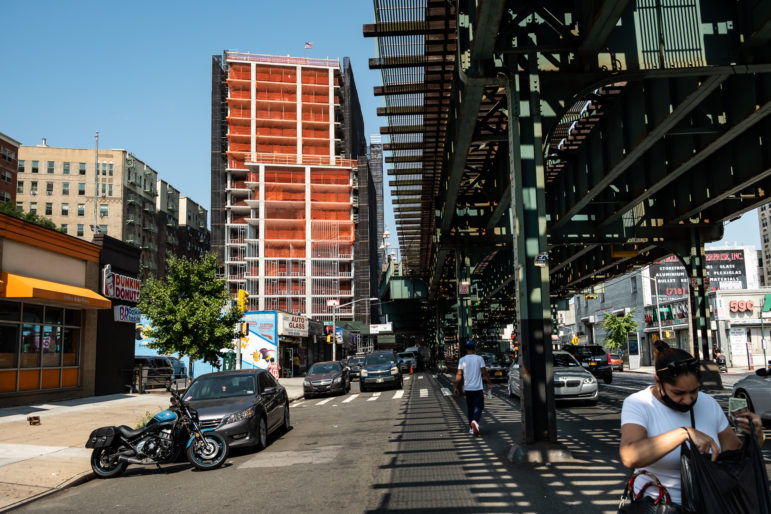
Adi Talwar
Looking North along Jerome Avenue at a construction site located at 1769 Jerome Avenue.In 2015, the de Blasio administration announced its plan to rezone 15 neighborhoods as part of its drive to create or preserve 200,000 affordable housing units—a goal the mayor upped in 2017 to 300,000 units.
So far, the city has approved six rezonings: East New York, Downtown Far Rockaway, East Harlem, Jerome Avenue and Inwood. A bid to rezone Flushing West was withdrawn early on, talk of a Long Island City rezoning fizzled out, and, over the past year, efforts to rezone parts of Southern Boulevard in the Bronx and Bushwick fell apart.
With less than 16 months left in the mayor’s second and final term, the last remaining rezoning will likely be Gowanus in Brooklyn, which could move into the public review process soon.
Before the rezonings, a mandatory inclusionary housing (MIH) rule was approved by City Council in 2016 and today every neighborhood upzoning requires developers building in the rezoned area to provide a percentage of the new housing units at “affordable” rents, with rent levels defined by the city. There remains intense debate over whether the rezonings create truly affordable units or instead drive speculation and gentrification.
Under MIH, the city has created 2,247 housing units in total since the MIH was enacted in 2016: for Manhattan 453 units, for the Bronx 943 units, for Brooklyn 649 units and for Queens 752 units, thus far, according to the city’s Housing Preservation Development own data from June 30th, the lead housing agency.
Here is a roundup of where development and neighborhood investment stands in each area affected by the approved rezoning:
East New York
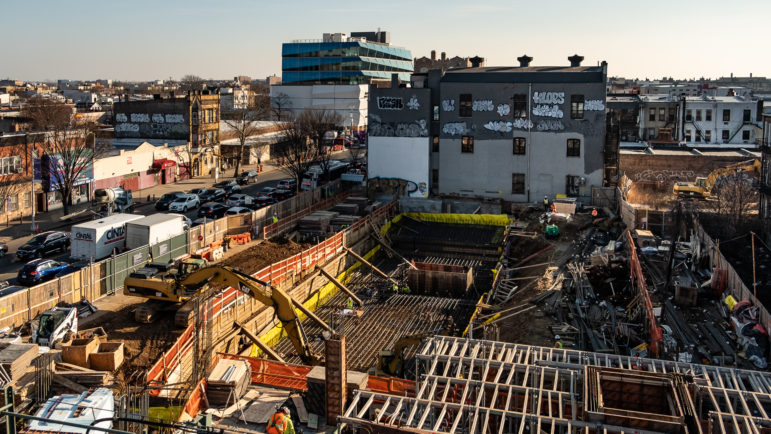
Adi Talwar
50 Pennsylvania Avenue, one of several affordable housing development sites in East New York. While housing creation has lagged, there are multiple projects in the pipeline. But there are concerns about how budget cuts might imperil future deals.The East New York rezoning of 2016 spanned 190 blocks in the East New York, Cypress Hills and Ocean Hill neighborhoods. It was supposed to bring affordable housing, economic development, enhanced open space, new schools and other investments after community members and elected officials negotiated with the city for a $250 million capital commitment.
In the East New York rezoning points of agreement, a document which lists the capital investments negotiated between the administration and then-City Councilmember Rafael Espinal, the city promised 1,300 affordable housing units — under the Mandatory Inclusionary Housing rule — in the first two years of the rezoning. Overall, the rezoning action could bring in 3,538 dwelling units over a 15 year period (by 2030), according to the environmental impact statement.
According to HPD, 187 MIH housing units have been created since the rezoning passed in 2016.
It also promised to publish a study for a pilot basement legalization program, build a 1,000-seat new school, acquire or renovate a new childcare center, and complete projects to improve transportation infrastructure, local parks, community centers and the environment over a 15-year period. Another promise included the revitalization of the East New York Industrial Business Zone with 20 commitments that would have brought in over $16 million in infrastructure improvements and make better use of underutilized properties. Those commitments would provide space for 250 additional companies and 4,000 new jobs.
In the most recent city budget, the basement pilot program suffered a major cut and its future looks bleak. To community organizations such as Cypress Hills Local Development Corporation, the basement pilot program was seen as a crucial tool to help middle-to lower-income households to keep their homes.
For some long-time East New York residents and businesses, two important concerns in the years since the rezoning have been the arrival of speculative real-estate predators and the lack of new jobs in the industrial business zone. Both groups have said the city has been slow to respond to those concerns.
“Where are these jobs?,” said Franklyn Mena, a longtime East New York resident and founder of Universe City, a food justice farm community. “We need those jobs now more than ever.”
Mena said his group has distributed an estimated 600,000 pounds of food since the pandemic began to address the food insecurity in the East New York community. He began his business two years ago in the East New York IBZ expecting more development in the coming years and has yet to see any progress.
Groups such as the Coalition for Community Advancement, an East New York coalition of residents, small businesses, homeowners, local community organizations (including faith-based groups)—along with other community members who have seen rapid real-estate speculation since the rezoning passed—have taken matters into their own hands. Earlier this year in March, East New York residents proposed to the NYS Department of State to create a cease-and-desist zone within the East New York rezoning boundary.
A cease-and-desist zone designation prohibits “solicitation of a real-estate listing from any homeowner whose name appears on a Department of State issued cease and desist list.” The Department of State just completed their community comments section for the cease-and-desist zone proposal on August 30th. Coalition for Community Advancement is waiting for a response from the Department of State.
The group also supports the 2019 Small Home Anti-Speculation Act, introduced by Senator Julia Salazar, which would impose a tax on the “transfer of certain real property within two years of the prior transfer of such property.” The bill is currently in the Senate’s Cities Committee.
“There are two sides of the rezoning, one is the commitments, ensuring the city fulfills the commitments they made such as to create and preserve housing, and then there is the other side: The rezoning unlocked this wave of [real estate] speculation which had not existed before,” says Alexa Sloan, organizing member of the coalition. “So cease-and-desist is one tool in trying to combat speculation, flippers, LLCs, cash-buyers coming into the neighborhood since 2016 to try to buy up as much real estate as possible, sometimes through [harassment] and [fraud].”
Downtown Far Rockaway
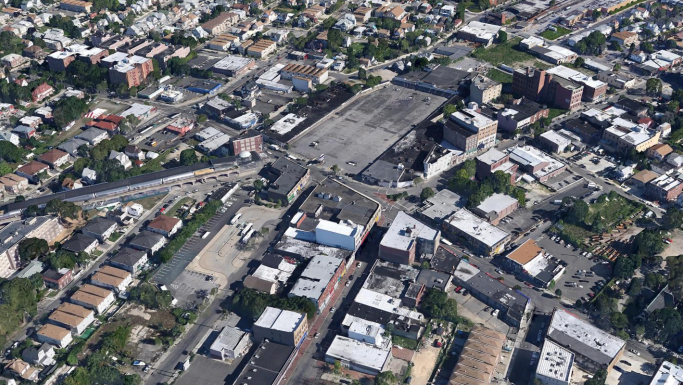
NYCEDC
The large black spot in the midst of this aerial shot of downtown Far Rockaway is the decrepit shopping center at the heart of the redevelopment plan.The 20-block Far Rockaway rezoning is expected to create an estimated 3,000 new housing units. The city began construction two years ago at the abandoned shopping center on Mott Avenue to make way for Far Rockaway Village, a project comprising 700 units of housing and 90,000 square feet of retail and commercial space. There’s another commercial and residential project just a few blocks away and there are plans for a 219-unit mixed-use residential and commercial building nearby.
An estimated $200,000 has been awarded in grants for cultural and community organizations since the 2017 rezoning.
Both the firehouse at 16-15 Central Avenue and the 101st Precinct Police Station at 16-12 Mott Avenue were landmarked because of their Renaissance and Colonial Revival design. The construction for a new library is underway and last year the city invested $139 million for a three-year infrastructure-improvement project.
Last year in November, the City Council gave approval for the Edgemere Commons mega-project which is slated to bring 2,050 units of mixed-income affordable housing units. However, because of city budget cuts, affordable housing projects could see delays in development and construction, according to advocates.
According to HPD, so far, the city has created 513 MIH housing units in the area since the rezoning was approved.
Community Board 14 District Manager Jonathan Gaska says the city is also looking to begin the review process for two other development sites: the Arverne East site, a 80-acre site slated for 1,500 housing units and 300,000 square feet of retail, and another manufacturing site in the coming weeks.
Gaska says some affordable housing construction sites have been moving quickly despite the pandemic and the biggest complaint from residents is “the lack of parking space.”
East Harlem

Abigail Savitch-Lew
A direct action by the Justice Center en El Barrio disrupts the City Council hearing on the East Harlem rezoning, October 11, 2017.The East Harlem rezoning spanned approximately 96 rezoned blocks bounded by East 104th Street to the south, East 132nd Street to the north, Park Avenue to the west and Second Avenue to the east. The rezoning is slated to create 2,600 housing units across several publicly owned sites.
The NYC Economic Development Corporation started accepting bids in October for the African burial site at the 126th Street MTA bus depot where the city has planned for a permanent outdoor memorial at the location of the burial ground and a cultural education center located in an adjacent building.
At the One East Harlem site on East 125th Street construction work topped out in June and is slated to create 300 affordable apartments and 100 market-rate units with space for community facility and public open space, according to YIMBY. Thus far, there have been no MIH housing units created since the rezoning was approved, according to HPD.
Jerome Avenue
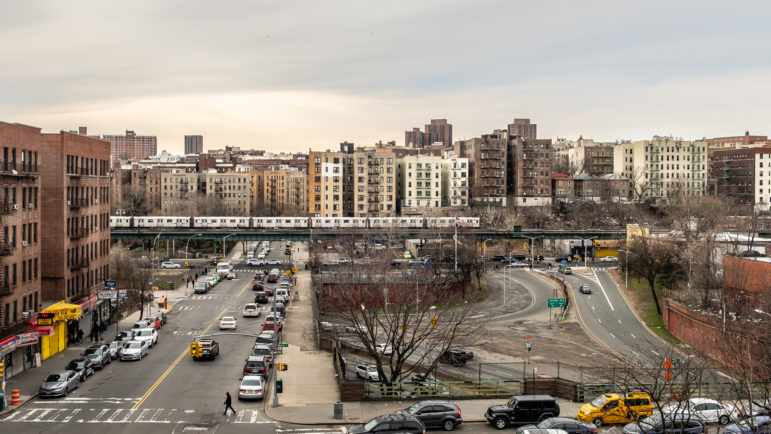
Adi Talwar
A view from the Grand Concourse of Jerome Avenue with its elevated 4 train, the Cross Bronx Expressway ramps and 174th Street.The 2018 Jerome Avenue rezoning, one of the most fiercely contested of the neighborhood redevelopment plans pursued by the de Blasio administration, spanned a 92-block area of the Bronx including the Jerome Avenue corridor.
The rezoning requires a percentage of new development to be income-targeted under the city’s mandatory inclusionary housing program and includes $189 million in capital investments ranging from affordable housing and economic development to open space and education.
Under the mandatory inclusionary housing program, developers have created 173 housing units in the area, according to the most recent data provided by HPD.
The rezoning’s points of agreement negotiated between the de Blasio administration and local City Councilmembers Vanessa Gibson and Fernando Cabrera also included the establishment of the Jerome Avenue Public Health Taskforce.
The task force includes more than a dozen Bronx-based members, ranging from housing advocacy groups and educational institutions to local elected officials and community boards. It has been charged with compiling a “check-list” based on recommendations received during public forums. The check-list will then be used to guide projects or programs undertaken as part of the rezoning. The city’s Department of Health and Mental Hygiene (DOHMH) has been working with the task force to help navigate how the community and city could address issues like safety, housing, physical environment, the food landscape and more that could impact the overall public health of the community. A report of the task force’s findings is due in the coming months.
Resident, community advocate and organizer with Community Action for Safe Apartments, Fitzroy Christian says there has been tons of construction in the main corridor, but one of the concerns Christian raised was small businesses appear to be closing along the main corridor in Jerome Avenue for unknown reasons. “We aren’t sure if the businesses have closed due to the COVID-19 crisis or due to the impact from the rezoning,” says Christian. “It has been difficult to properly assess the changes under the pandemic.”
Inwood
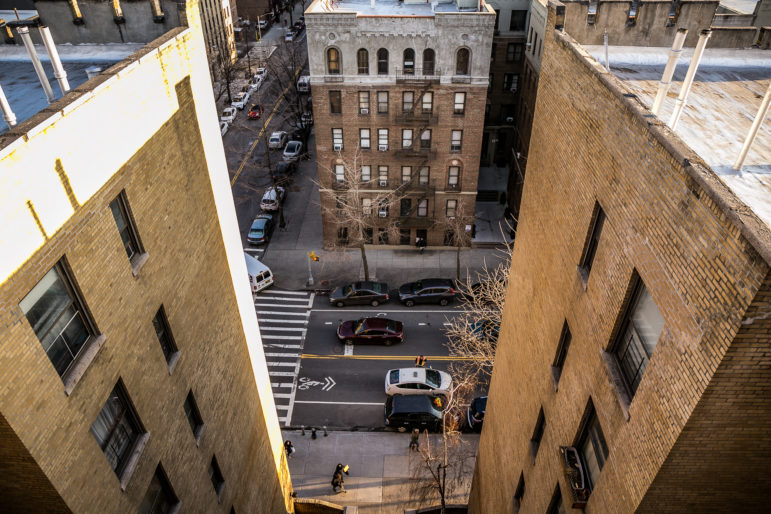
Adi Talwar
Corner of 204 Street and Seaman Avenue in what was deemed the Upland Core of the Inwood rezoning area.The Inwood rezoning was approved by the City Council in August 2018 and was slated to bring residential and commercial development eastward across 10th Avenue to the Harlem River, while applying contextual zoning —to preserve neighborhood character—to several residential areas west of 10th Avenue.
The estimated $500 million rezoning plan would have facilitated 2,600 new affordable housing units under the mandatory inclusionary housing (MIH) program and preserved another 2,500 existing affordable homes, according to the city. It included a plan to replace the Inwood library with a new residential building which would sit atop a new library.
Local opponents of the rezoning—who said the city had failed to fully explore the risk of residential displacement and other impacts in its environmental review—sued to overturn the approval. In December 2019, a state court agreed with them and annulled the Council’s vote. An appeals court reversed that ruling in July, and the opponents are now seeking leave to appeal the case to the state’s highest court. The continued legal battle has prevented any major rezoning-related development in the area.
Bay Street Corridor
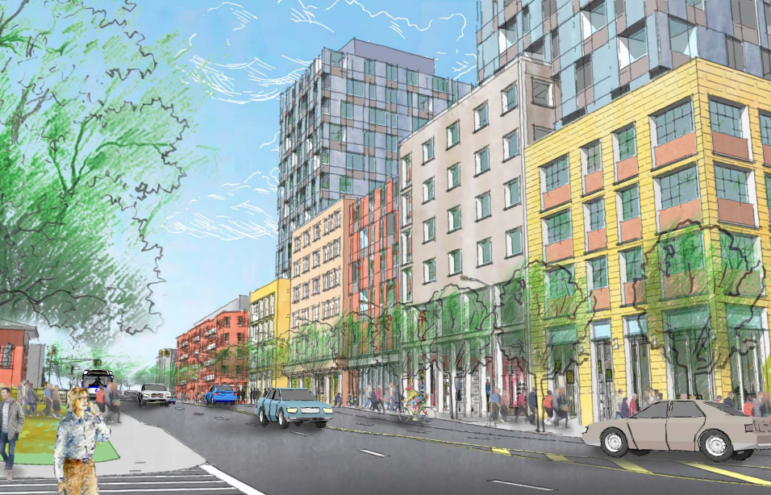
NYC DCP
A rendering in a de Blasio administration presentation on the rezoning envisions what the new Bay Street corridor will look like.Last year in June, the City Council approved the Bay Street Corridor rezoning plan proposed by the city administration. The plan was in the making for over five years. It rezoned 20 blocks of Staten Island’s North Shore and could lead to the creation of 1,800 new units of housing, including 1,300 income-targeted apartments. The city has promised $250 million in local investments. The plan includes the St George, Tompkinsville and Stapleton neighborhoods.
According to HPD, there have been zero housing units created under the Mandatory Inclusionary Housing program in the Bay Street rezoning area as of yet.
On Thursday, the city will hold its first virtual community engagement for an affordable housing development project on what is known as Stapleton Site A near Hannah Street, which is slated for 300 affordable housing units and has the possibility for ground floor community/retail spaces. Site A is located along the New Stapleton Waterfront District—a 35-acre decommissioned Navy base that has been designated for a mixed-use neighborhood of housing, retail, community facilities and waterfront open space. That designation was made in conjunction with the Bay Street Corridor rezoning. The online engagement meetings can be found here.
According to state Department of Environmental Conservation records, DEC is surveying 475 Bay Street, near Wave Street, for brownfield remediation. The site is slated for a mixed-use building with residential and commercial space which will include 274 housing units.









